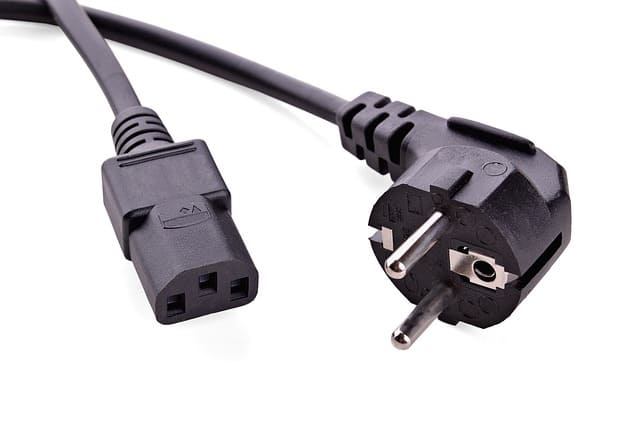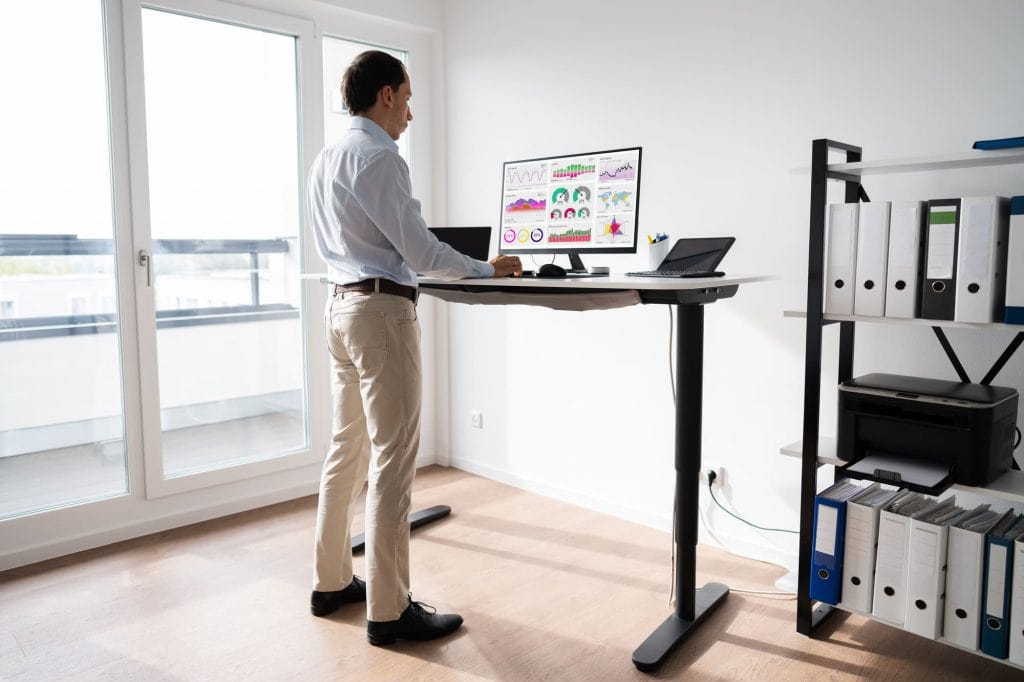*When you buy through links on our site, we may earn an affiliate commission at no additional cost to you.
Let’s face it…standing desks are at their basic level, electronic devices. And just like any other electric motor-operated system, they can fail at any given time.
One of the most common problems users face with these desks is the tabletop failing to go up after assembly or continued use. and even the led display shows an error code. When this happens, you shouldn’t panic or start contacting the manufacturer for a return.
Our guide below discusses the quick fixes and answers on why your standing desk won’t go up, to help resolve these issues and get your desk in the perfect working order.
Table of Contents
7 Common causes behind standing desks not going up:
Here are the 7 most common reasons why your stand-up desk doesn’t travel up to your desired height setting and the best solution for each problem.
#1. Your stand-up desk has surpassed its lifting capacity
As you already know, the height-adjustable desks usually come with a weight limit—indicating the maximum amount of weight you shouldn’t exceed on their tabletop.

An overload can happen if your desk exceeds its lifting capacity if you load it with too many items. This forces your desk to shut off.
In other words, the desk tells you, “hey, you’re overburdening me, and I can’t go up any further!” And your desk is damn right…because forcing its way up will damage its components.
Prevention: Besides solving this issue, you can also prevent this by bearing in mind your desk’s maximum load capacity. And make sure you confirm whether the weight rating stands for desk frame only or desk frame + workspace.
If it reads base only, it means whatever you put on top of the desk base (including the worktop itself) shouldn’t exceed the maximum value.
#2. Look for obstacles standing in the way
Before getting into more serious causes, check whether there are any obstacles standing in the way of your standing desk path and restricting its upward movement.
You may find that mounted shelves, cabinets, or artwork sitting right above the desk travel path.
Your standing desk may have a safety feature (collision detection feature)[1]. This helps prevent the desk from hitting the object.
This is how it works:
When the feature detects an object ahead, it stops abruptly and prevents it from moving upward. It will then go slightly downward to give you sufficient room to get the obstacle out of the way.
Solution: To solve this problem, you should look for any items above your desk, right on their travel path, and get rid of them. However, some desks may require a reset procedure. If you’re dealing with permanent installations like shelves, you may consider changing your sit-stand desk position.
#3. Your desk may have lost power
The electric desks must be plugged in since they rely on power to run their electric motors for smooth up and down movement. That said, loss of power can render it unable to move up to your desired level.
Power loss can happen due to several ways. The most common one is power loss in the outlet. However, sometimes we can mess up the power cable unknowingly, leading to accidentally unplugging the unit.

When your unit loses and regains power, it may not always get back to normal. Instead, it may enter rest mode—where it can only go downwards and not upwards.
Solution: You must do a manual reset procedure on your table to take it from the resting mode and enables it to smoothly go up again. (More details on how to reset a standing desk reset later).
Prevention: ALWAYS check that your standing desk is plugged into the power source and that the outlet is giving out power.
#4. The control box has exhausted its duty cycle
Most people don’t know this, but the control box that houses the brain of your standing desk gets exhausted.
This happens after it controls soo many up and down movements on your desks, and it needs to rest.
This is what the experts refer to as the Duty cycle. It simply indicates how long the control box stays active (allowing up/down desk movement) and how long it stays inactive (in the rest mode).

Most standing desk control boxes are rated Duty Cycle: 10%, 2 min ON/18min OFF. 10% expresses the duty cycle in percentage, which is a ratio of time on to time off. 2 min ON means it stays active for 2 minutes, and 12MIN OFF means it goes to rest mode for 18 good minutes.
When this standing desk brain hits the maximum amount of its active time, it automatically switches to rest mode. This is necessary to prevent overheating and possible damage to its components.
Solution: In this situation, there isn’t much you can do but give your control box up to 18 minutes to come back up from the rest mode. Sometimes it can recover before the 18 minutes are over. In most cases, the desk will continue functioning normally after the rest period is over. If it doesn’t, you can go for a manual reset.
WARNING: Some people recommend doing a manual rest to override the duty cycle. This can help you avoid waiting for long periods of 18 minutes. But we don’t recommend it as it can cause your standing desk brain and get damaged, prompting a replacement.
#5. Uneven legs may be the culprit
Some standing tablers come equipped with dual motors, each for controlling its own set of legs. Such models usually have the issue of uneven legs since they’re independently operated.
This happens when the motors lack a good self-locking mechanism. The motor and spindle turn instead of marinating their height position.
One of the motors may turn while the other stays still or makes more/fewer turns than your first motor. This causes the two motors to get out of sync and leave your desk legs uneven.
When the legs become uneven, the desk’s control box may recognize this issue and stop moving up to prevent potential desk damage.
And if the desk brain isn’t sophisticated enough to detect the unevenness, the desk continues moving up and down. This results in too much friction within its leg columns, causing them to get stuck and stop moving.
Solution: The best fix for this is to perform a complete desk reset to get everything back to normal and cause the legs to be realigned and even again.
#6. The upper container may have halted
The upper container in stand-up desks refers to the setting you create to reprogram your desk maximum height.
For instance, if your desk has a maximum height of 46 inches, you can change it to 40 inches, depending on your needs and preferences.
This setting may be another “obstacle” causing your desk to not reach your desired height.
Solution: Simply delete or change the setting to allow your standing desk to go higher.
#7. Check if the desk connection cables are securely connected
Poor cable management can easily lead to the wires connecting the desk becoming loose. This means power flowing through the cables and to your desk’s control box and motors is inconsistent.

Your desk will translate this as an outage, and it will most likely go into rest mode. As we mentioned earlier, tables in rest mode can only go down and not up!
Solution: When faced with this problem, you need to do a manual reset process for your desk. You’ll need to press and hold the down button until the desk reaches its lowest height to manually reset it. But before you do that, check for the loose connections on your motor and leg cables and correct them.
Prevention: To prevent this issue from happening again, make sure you have a cable management system in your workstation. This will help keep cables out of the way. Good wire management can also prevent tripping hazards, leading to costly damages around workspaces.
How to do a standing desk manual reset:
Manual reset in an electric standing desk is one height adjustable desk troubleshooting HACK that solves most of the standing desk problems—including the desk not going up. It takes the desk to factory settings to help it to continue functioning normally.
The process is pretty simple and involves easy and quick steps as outlined below:
Step 1. Unplug the standing desk from the electrical outlet and leave it for 30 seconds
Step 2. Inspect all the cable connections for the desk motor and control box to ensure they’re properly connected.
Step 3. Now plug the desk back in
Step 4. Clear anything below the desk that may obstruct the downward movement. Press and hold the down button until the desk reaches its lowest point. Release the down button.
Step 5. Press and hold the down arrow again for approx. 10 seconds, then release.
Your desk lowers slightly and then rises a bit before coming to a stop. This is an indication of a successful reboot. You may hear a few clicks in some models like the FlexiSpot height adjustable desk. This means your desk is now as good as new and ready to use again.
NOTE: These reset instructions will work for most sit-stand tables. But we advise you to go through your standing desk user manual for instructions specific to your specific model.
Also read: What does ASR mean on a standing desk?
Wrap up – Why Your Standing Desk Won’t Go Up
It’s not uncommon for sit-stand desks to develop hiccups as you continue using them. Remember, they feature electric components that will fail at one point.
When you’re faced with the problem of your standing desk not going up, you can easily resolve this on your own by following the fixes we have just outlined above.
If your standing desk is still having issues after trying all the recommended fixes, contact the customer support team for additional height adjustable desk troubleshooting tips and professional help.



